Prediction of Sunlight- and Salinity-Driven Inactivation Kinetics of Microbial Indicators with Validation in a 3D Water Quality Model
Abstract
:1. Introduction
2. Materials and Methods
2.1. Laboratory Experiment
2.2. Study Area and Water Quality Monitoring
2.3. Three-Dimensional Water Quality Model
- = basic inactivation coefficient = 0.045 (day−1)
- = inactivation coefficient depending on salinity = 0.100 (day−1PSU−1)
- = salinity level (PSU)
- = inactivation factor by sunlight = 0.038 (m2day−1W−1)
- = solar irradiance (Wm−2)
- = extinction coefficient = 0.65 (m−1)
- = water depth (m)
3. Results
3.1. Inactivation Kinetics of Fecal Bacteria and Bacteriophages
3.2. Water Quality Monitoring at Tokyo International Cruise Terminal
4. Discussion
4.1. The Reproducibility of E. coli Concentration in the Water Quality Model
4.2. Effect of Salinity and Solar Radiation to E. coli Inactivation
5. Conclusions
- Somatic coliphages illustrated the highest persistence to both solar radiation and salinity with kI = 0.001 (m2day−1W−1) and kS = −0.010 (day−1PSU−1), whereas fecal bacteria were found to be more susceptible with enterococcus and persisted with kI = 0.013 (m2day−1W−1) and kS = 0.012 (day−1PSU−1). This is owing to the thick cell wall structure of the enterococcus, enabling it to be more resilient to external stresses such as high osmotic pressure.
- For the inactivation of E. coli, the effects of both factors were investigated further. Calculations indicated that solar radiation was a stronger factor dominating the survival time of E. coli. It should be noted that this conclusion was drawn without considering the complication regarding the interaction between solar radiation and salinity.
- Consequently, it is imperative to develop strategies for mitigating the impact of CSO that address not only frequent small to moderate rainfall events but also extended periods of rainfall lasting several days. For instance, implementing a scenario analysis focused on source control measures, such as optimizing the operation of stormwater reservoirs and pumping stations, can effectively reduce pollutant discharges during these prolonged rainfall events. This approach is particularly significant, given the demonstrated correlation between extended rainfall periods, reduced solar radiation exposure, and the prolonged survival of E. coli and other microbial indicators.
- In the second phase, we integrated experimentally validated inactivation kinetics of E. coli, a well-known and widely used fecal indicator, and a validated hydrodynamic water quality model. The accuracy of the modelled predictions was affirmed by daily monitoring data of actual situations. The trend of modelled E. coli corresponded well with monitoring data, showing a concentration difference of less than 1 log. The validated water quality model can be used for timely bathing water quality predictions, as well as assistance in decision making for water pollution control in the area and elsewhere.
Supplementary Materials
Author Contributions
Funding
Data Availability Statement
Acknowledgments
Conflicts of Interest
References
- Furumai, H. Environmental Management and Technology: cSUR-UT; Library for Sustainable Urban Regeneration, Volume 1; Springer: Tokyo, Japan, 2008; pp. 29–46. [Google Scholar]
- Combined Sewer Overflow Control: Surprising Sewerage. Available online: https://www.mlit.go.jp/english/2006/d_c_and_r_develop_bureau/02_surprise/06_02_1011_p910_combined.html (accessed on 10 January 2024).
- Hajj-Mohamad, M.; Aboulfadl, K.; Darwano, H.; Madoux-Humery, A.S.; Guérineau, H.; Sauvé, S.; Dorner, S. Wastewater micropollutants as tracers of sewage contamination: Analysis of combined sewer overflow and stream sediments. Environ. Sci. Process Impacts 2014, 16, 2442–2450. [Google Scholar] [CrossRef]
- Liu, J.L.; Wong, M.H. Pharmaceuticals and personal care products (PPCPs): A review on environmental contamination in China. Environ. Int. 2013, 59, 208–224. [Google Scholar] [CrossRef]
- Phillips, P.J.; Chalmers, A.T.; Gray, J.L.; Kolpin, D.W.; Foreman, W.T.; Wall, G.R. Combined sewer overflows: An environmental source of hormones and wastewater micropollutants. Environ. Sci. Tech. 2012, 46, 5336–5343. [Google Scholar] [CrossRef]
- Sang, Z.; Jiang, Y.; Tsoi, Y.K.; Leung, K.S.Y. Evaluating the environmental impact of artificial sweeteners: A study of their distributions, photodegradation and toxicities. Water Res. 2014, 52, 260–274. [Google Scholar] [CrossRef]
- Ekhlas, D.; Kurisu, F.; Kasuga, I.; Cernava, T.; Berg, G.; Liu, M.; Furumai, H. Identification of new eligible indicator organisms for combined sewer overflow via 16S rRNA gene amplicon sequencing in Kanda River, Tokyo. J. Environ. Manag. 2021, 284, 112059. [Google Scholar] [CrossRef]
- Botturi, A.; Ozbayram, E.G.; Tondera, K.; Gilbert, N.I.; Rouault, P.; Caradot, N.; Gutierrez, O.; Daneshgar, S.; Frison, N.; Akyol, Ç.; et al. Combined sewer overflows: A critical review on best practice and innovative solutions to mitigate impacts on environment and human health. Crit. Rev. Environ. Sci. Technol. 2021, 51, 1585–1618. [Google Scholar] [CrossRef]
- Owolabi, T.A.; Mohandes, S.R.; Zayed, T. Investigating the impact of sewer overflow on the environment: A comprehensive literature review paper. J. Environ. Manag. 2022, 301, 113810. [Google Scholar] [CrossRef]
- Petrie, B. A review of combined sewer overflows as a source of wastewater-derived emerging contaminants in the environment and their management. Environ. Sci. Pollut. Res. 2021, 28, 32095–32110. [Google Scholar] [CrossRef] [PubMed]
- Zan, R.; Blackburn, A.; Plaimart, J.; Acharya, K.; Walsh, C.; Stirling, R.; Kilsby, C.G.; Werner, D. Environmental DNA clarifies impacts of combined sewer overflows on the bacteriology of an urban river and resulting risks to public health. Sci. Total Environ. 2023, 889, 164282. [Google Scholar] [CrossRef]
- Crocetti, P.; Eusebi, A.L.; Bruni, C.; Marinelli, E.; Darvini, G.; Carini, C.B.; Bollettini, C.; Recanati, V.; Akyol, Ç.; Fatone, F. Catchment-wide validated assessment of combined sewer overflows (CSOs) in a mediterranean coastal area and possible disinfection methods to mitigate microbial contamination. Environ. Res. 2021, 196, 110367. [Google Scholar] [CrossRef] [PubMed]
- Bertels, D.; De Meester, J.; Dirckx, G.; Willems, P. Estimation of the impact of combined sewer overflows on surface water quality in a sparsely monitored area. Water Res. 2023, 244, 120498. [Google Scholar] [CrossRef]
- Poopipattana, C.; Nakajima, M.; Kasuga, I.; Kurisu, F.; Katayama, H.; Furumai, H. Spatial Distribution and Temporal Change of PPCPs and Microbial Fecal Indicators as Sewage Markers after Rainfall Events in the Coastal Area of Tokyo. J. Water Environ. Technol. 2018, 16, 149–160. [Google Scholar] [CrossRef]
- Poopipattana, C.; Furumai, H. Fate Evaluation of CSO-derived PPCPs and Escherichia coli in Tokyo Coastal Area after Rainfall Events by a Three-dimensional Water Quality Model. J. Water Environ. Technol. 2021, 19, 251–265. [Google Scholar] [CrossRef]
- Poopipattana, C.; Suzuki, M.; Furumai, H. Impact of long-duration CSO events under different tidal change conditions on distribution of microbial indicators and PPCPs in Sumida river estuary of Tokyo Bay, Japan. Environ. Sci. Pollut. Res. 2021, 28, 7212–7225. [Google Scholar] [CrossRef]
- Passerat, J.; Ouattara, N.K.; Mouchel, J.M.; Vincent, R.; Servais, P. Impact of an intense combined sewer overflow event on the microbiological water quality of the Seine River. Water Res. 2011, 45, 893–903. [Google Scholar] [CrossRef]
- Al Aukidy, M.; Verlicchi, P. Contributions of combined sewer overflows and treated effluents to the bacterial load released into a coastal area. Sci. Total Environ. 2017, 607–608, 483–496. [Google Scholar] [CrossRef]
- Romei, M.; Lucertini, M.; Renzoni, E.E.; Baldrighi, E.; Grilli, F.; Manini, E.; Marini, M.; Iagnemma, L. A detention reservoir reduced combined sewer overflows and bathing water contamination due to intense rainfall. Water 2021, 13, 3425. [Google Scholar] [CrossRef]
- Ordulj, M.; Jozić, S.; Baranović, M.; Krželj, M. The Effect of Precipitation on the Microbiological Quality of Bathing Water in Areas under Anthropogenic Impact. Water 2022, 14, 527. [Google Scholar] [CrossRef]
- McMinn, B.R.; Ashbolt, N.J.; Korajkic, A. Bacteriophages as indicators of faecal pollution and enteric virus removal. Lett. Appl. Microbiol. 2017, 65, 11–26. [Google Scholar] [CrossRef] [PubMed]
- Dias, E.; Ebdon, J.; Taylor, H. The application of bacteriophages as novel indicators of viral pathogens in wastewater treatment systems. Water Res. 2017, 129, 172–179. [Google Scholar] [CrossRef] [PubMed]
- Muela, A.; García-Bringas, J.M.; Arana, I.; Barcina, I. The effect of simulated solar radiation on Escherichia coli: The relative roles of UV-B, UV-A, and photosynthetically active radiation. Microb. Ecol. 2000, 39, 65–71. [Google Scholar] [CrossRef] [PubMed]
- Jozić, S.; Morovié, M.; Šolić, M.; KrstuIović, N.; Ordulj, M. Effect of solar radiation, temperature and salinity on the survival of two different strains of Escherichia coli. Fresenius Environ. Bull. 2014, 23, 1852–1859. [Google Scholar]
- Maraccini, P.A.; Mattioli, M.C.M.; Sassoubre, L.M.; Cao, Y.; Griffith, J.F.; Ervin, J.S.; Van De Werfhorst, L.C.; Boehm, A.B. Solar Inactivation of Enterococci and Escherichia coli in Natural Waters: Effects of Water Absorbance and Depth. Environ. Sci. Technol. 2016, 50, 5068–5076. [Google Scholar] [CrossRef]
- Scroccaro, I.; Ostoich, M.; Umgiesser, G.; De Pascalis, F.; Colugnati, L.; Mattassi, G.; Vazzoler, M.; Cuomo, M. Submarine wastewater discharges: Dispersion modelling in the Northern Adriatic Sea. Environ. Sci. Pollut. Res. 2010, 17, 844–855. [Google Scholar] [CrossRef]
- Jalliffier-Verne, I.; Heniche, M.; Madoux-Humery, A.S.; Galarneau, M.; Servais, P.; Prévost, M.; Dorner, S. Cumulative effects of fecal contamination from combined sewer overflows: Management for source water protection. J. Environ. Manag. 2016, 174, 62–70. [Google Scholar] [CrossRef] [PubMed]
- Liu, W.C.; Huang, W.C. Modeling the transport and distribution of fecal coliform in a tidal estuary. Sci. Total Environ. 2012, 431, 16. [Google Scholar] [CrossRef] [PubMed]
- Sokolova, E.; Pettersson, T.J.; Bergstedt, O.; Hermansson, M. Hydrodynamic modelling of the microbial water quality in a drinking water source as input for risk reduction management. J. Hydrol. 2013, 497, 15–23. [Google Scholar] [CrossRef]
- Thupaki, P.; Phanikumar, M.S.; Beletsky, D.; Schwab, D.J.; Nevers, M.B.; Whitman, R.L. Budget analysis of Escherichia coli at a southern Lake Michigan beach. Environ. Sci. Tech. 2010, 44, 1010–1016. [Google Scholar] [CrossRef]
- Andersen, S.T.; Erichsen, A.C.; Mark, O.; Albrechtsen, H.J. Effects of a 20 year rain event: A quantitative microbial risk assessment of a case of contaminated bathing water in Copenhagen, Denmark. J. Water Health 2013, 11, 636–646. [Google Scholar] [CrossRef]
- De Marchis, M.; Freni, G.; Napoli, E. Modelling of E. coli distribution in coastal areas subjected to combined sewer overflows. Water Sci. Technol. 2013, 68, 1123–1136. [Google Scholar] [CrossRef]
- Eregno, F.E.; Tryland, I.; Tjomsland, T.; Kempa, M.; Heistad, A. Hydrodynamic modelling of recreational water quality using Escherichia coli as an indicator of microbial contamination. J. Hydrol. 2018, 561, 179–186. [Google Scholar] [CrossRef]
- ISO 10705-1; International Organisation for Standardisation: Water quality—Detection and Enumeration of Bacteriophage, Part 1: Enumeration of F-specific RNA Bacteriophages. International Organisation for Standardisation: Geneva, Switzerland, 1995.
- ISO/FDIS 10705–2; International Organization for Standardization: Water Quality—Detection and Enumeration of Bacterio- Phages—Part 2: Enumeration of Somatic Coliphages. International Organisation for Standardisation: Geneva, Switzerland, 2000.
- Suzuki, M.; Poopipattana, C.; Furumai, H. Effects of sunlight and salinity inactivation on the fate of fecal indicator microorganisms in raw sewage. J. Jpn. Soc. Civ. Eng. Ser. G Environ. Res. 2020, 76, 411–421. (In Japanese) [Google Scholar] [CrossRef] [PubMed]
- Historical Weather Data: Japan Meteorological Agency. Available online: https://www.data.jma.go.jp/obd/stats/etrn/index.php (accessed on 10 January 2024).
- Koibuchi, Y.; Sato, S. Advanced Monitoring and Numerical Analysis of Coastal Water and Urban Air Environment: cSUR-UT; Library for Sustainable Urban Regeneration, Volume 3; Chapter 3; Springer: Tokyo, Japan, 2010; pp. 33–69. [Google Scholar]
- Sinton, L.W.; Hall, C.H.; Lynch, P.A.; Davies-Colley, R.J. Sunlight Inactivation of Fecal Indicator Bacteria and Bacteriophages from Waste Stabilization Pond Effluent in Fresh and Saline Waters. Appl. Environ. Microbiol. 2002, 68, 1122–1131. [Google Scholar] [CrossRef] [PubMed]

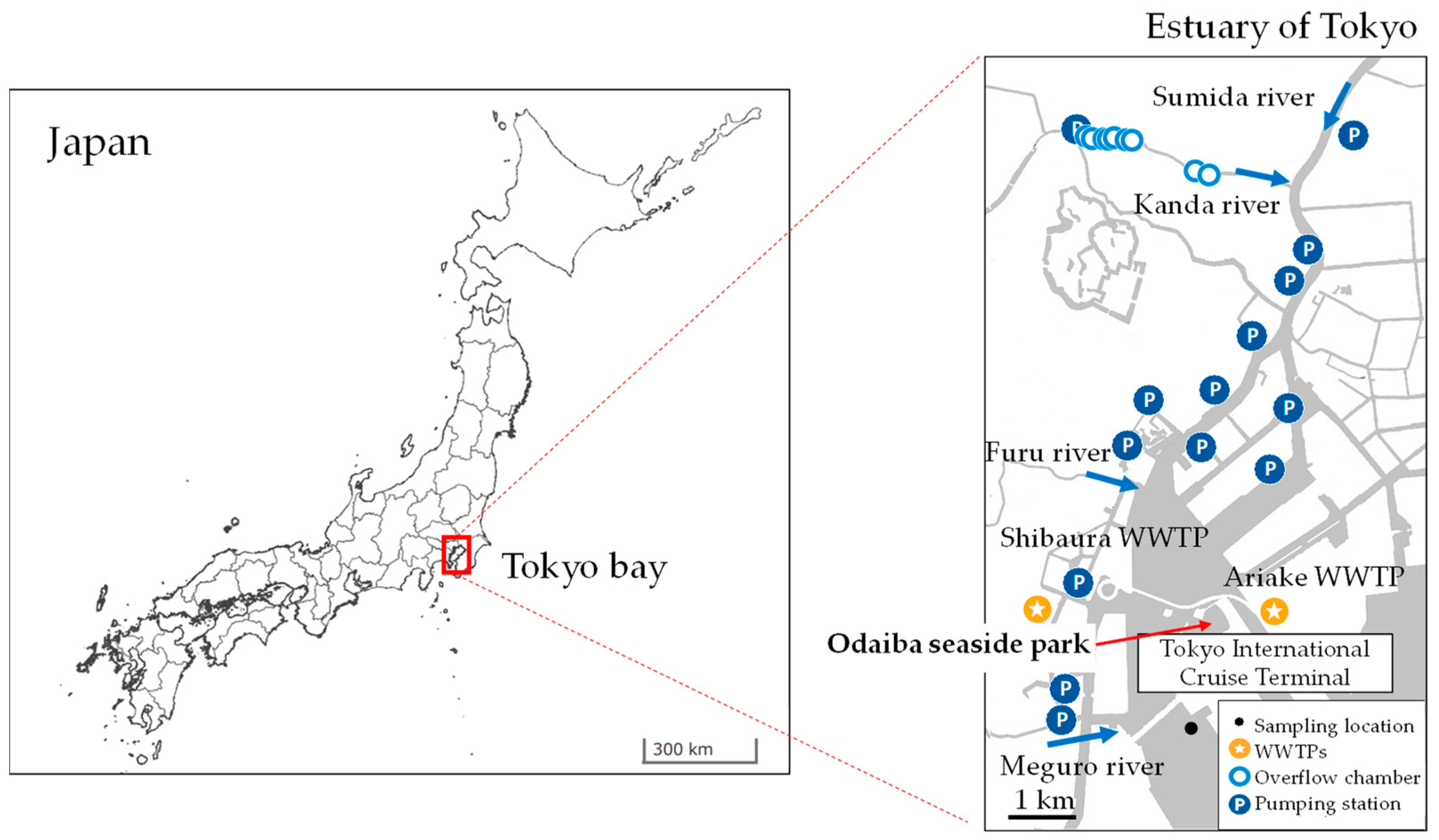

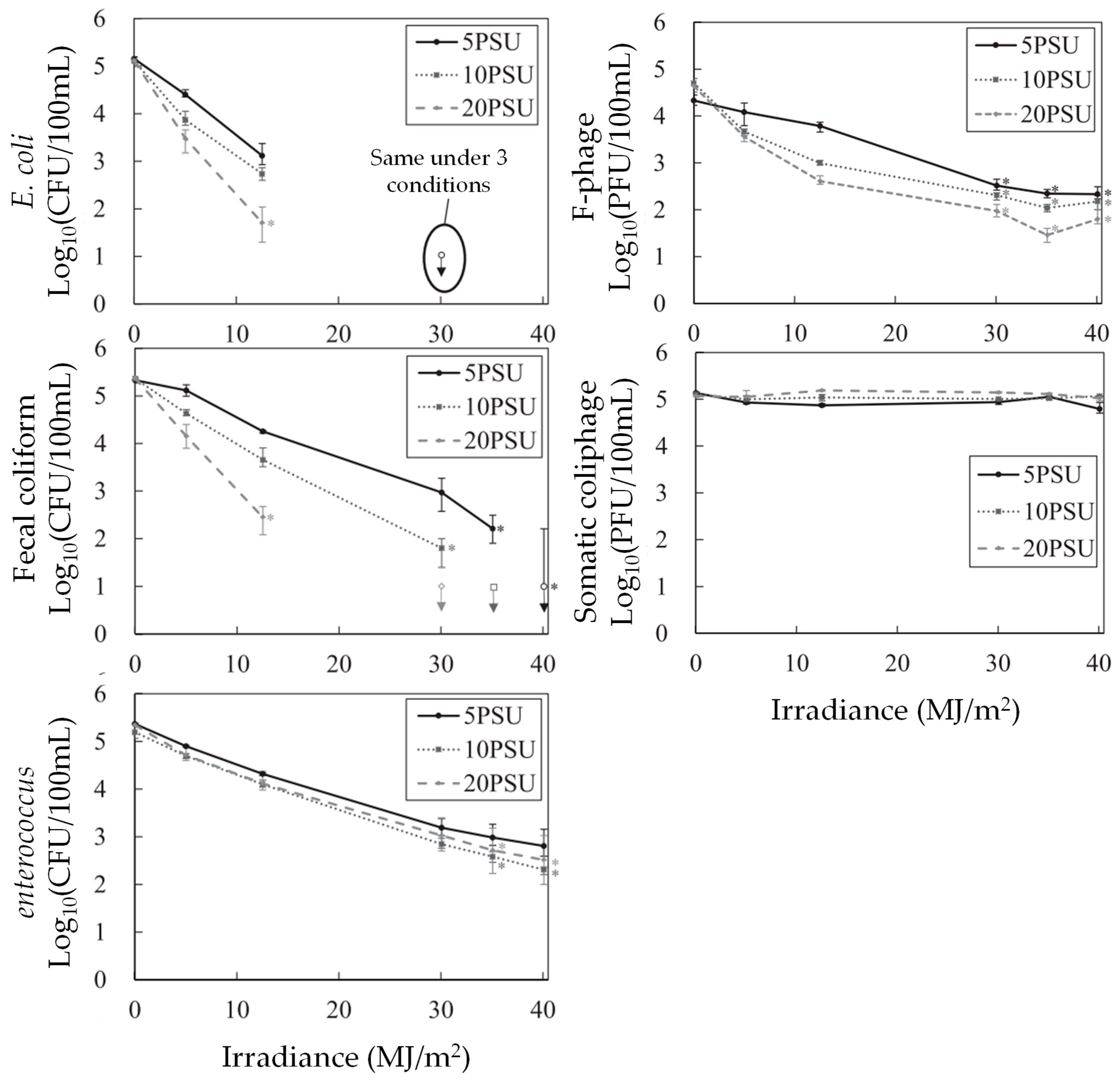
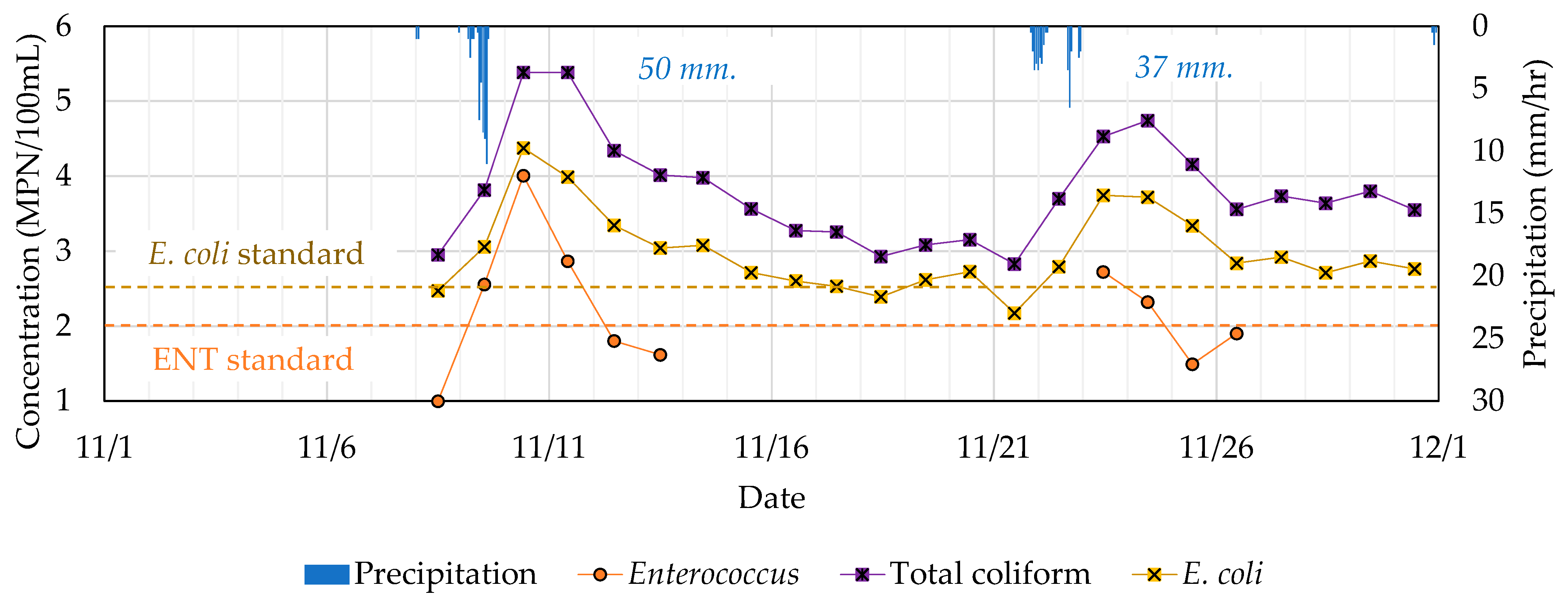
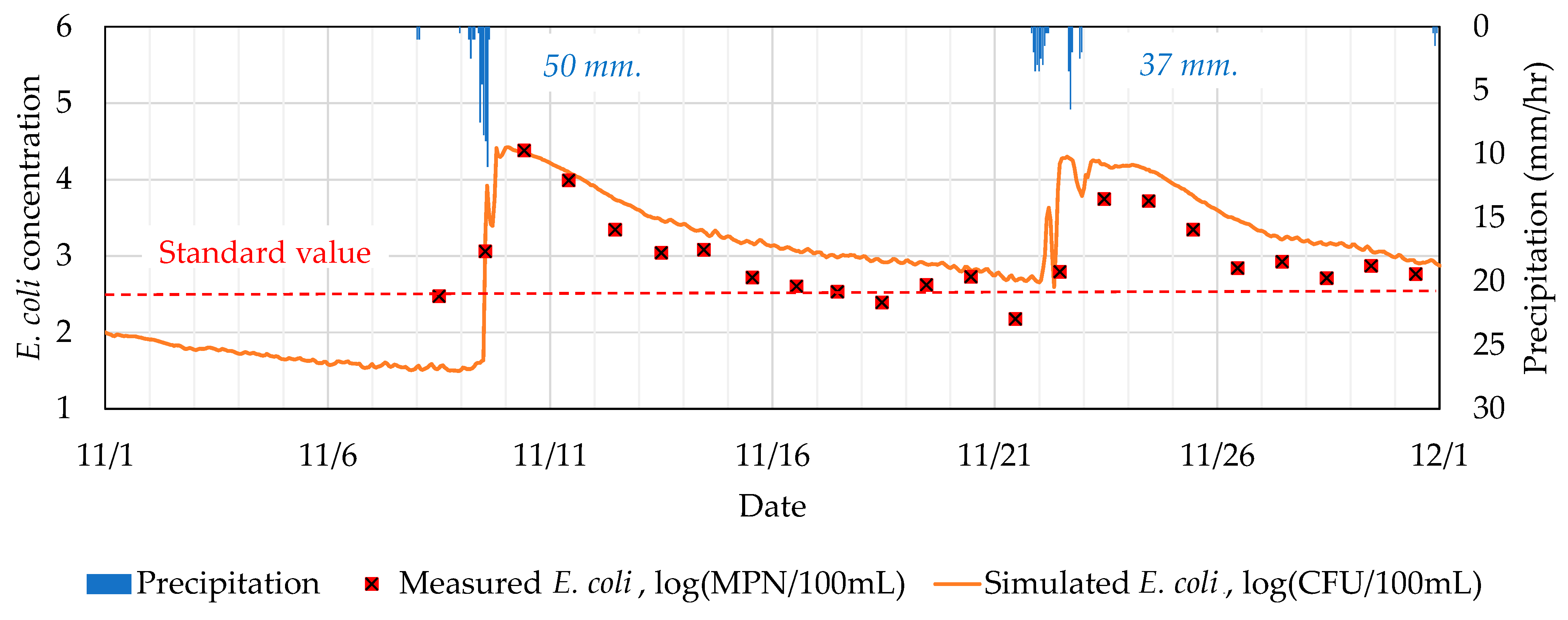
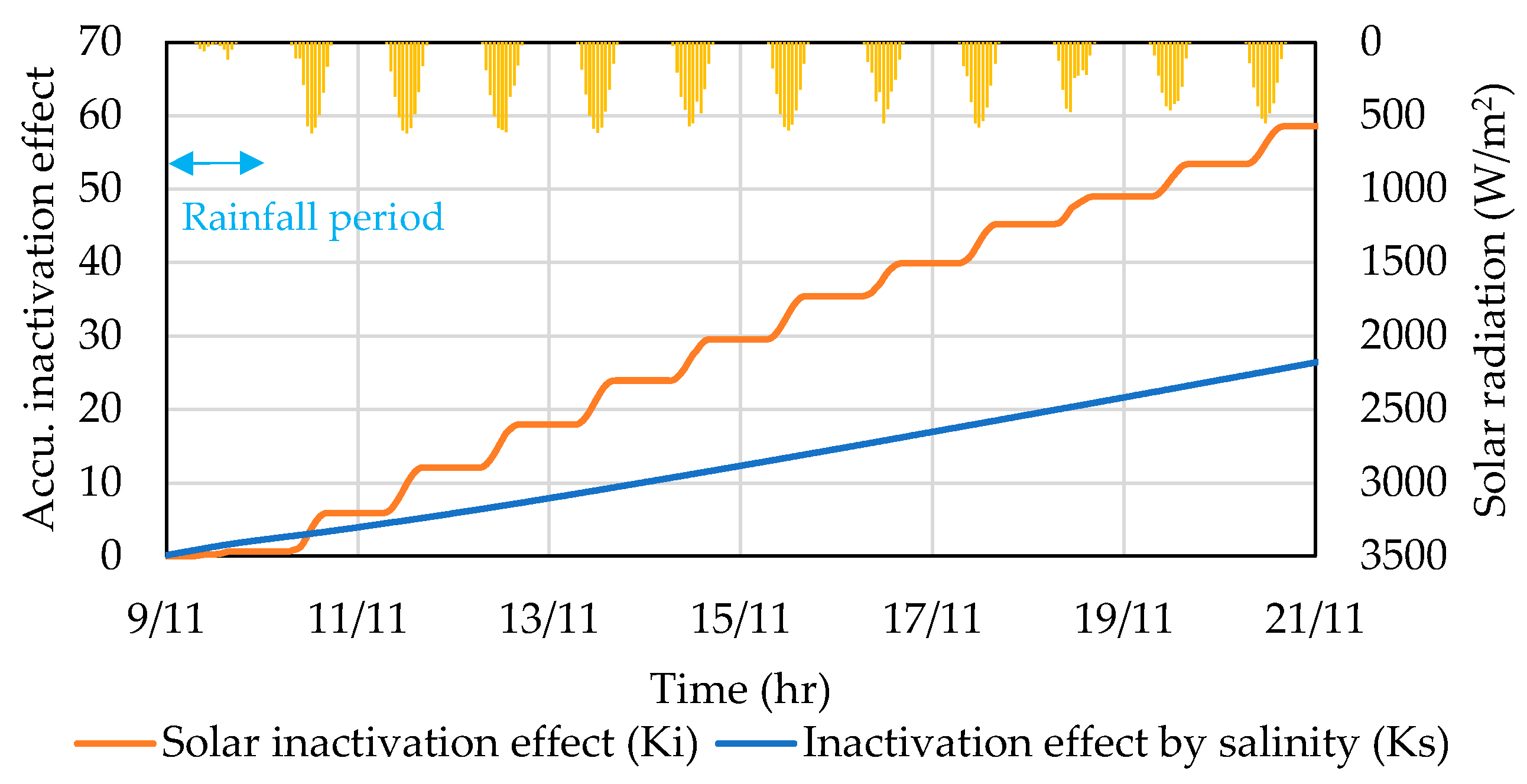
| Microbial Indicators | Light Condition | Salinity (PSU) | R2 | kb (Day−1) | p-Value | kS (Day−1PSU−1) | p-Value | kI (m2Day−1W−1) | p-Value |
|---|---|---|---|---|---|---|---|---|---|
| E. coli | Dark | 0 | 0.95 | 0.045 | 0.38 | - | - | - | - |
| Dark | 0, 10, 20 | 0.96 | - | - | 0.100 | 0.08 | 0.038 | 0.00 | |
| Light | 5, 10, 20 | ||||||||
| enterococcus | Dark | 0 | 0.96 | 0.382 | 0.15 | - | - | - | - |
| Dark | 0, 10, 20 | 0.98 | - | - | 0.012 | 0.31 | 0.013 | 0.00 | |
| Light | 5, 10, 20 | ||||||||
| Fecal coliform | Dark | 0 | 0.98 | −0.168 | 0.11 | - | - | - | - |
| Dark | 0, 10, 20 | 0.86 | - | - | 0.127 | 0.09 | 0.025 | 0.00 | |
| Light | 5, 10, 20 |
| Microbial Indicators | Light Condition | Salinity (PSU) | R2 | kb (Day−1) | p-Value | kS (Day−1PSU−1) | p-Value | kI (m2Day−1W−1) | p-Value |
|---|---|---|---|---|---|---|---|---|---|
| F-phage | Dark | 0 | 0.68 | 0.261 | 0.03 | - | - | - | - |
| Dark | 0, 10, 20 | 1.00 | - | - | 0.073 | 0.00 | 0.010 | 0.00 | |
| Light | 5, 10, 20 | ||||||||
| Somatic coliphage | Dark | 0 | 0.20 | 0.019 | 0.78 | - | - | - | - |
| Dark | 0, 10, 20 | 0.73 | - | - | −0.010 | 0.00 | 0.001 | 0.00 | |
| Light | 5, 10, 20 |
Disclaimer/Publisher’s Note: The statements, opinions and data contained in all publications are solely those of the individual author(s) and contributor(s) and not of MDPI and/or the editor(s). MDPI and/or the editor(s) disclaim responsibility for any injury to people or property resulting from any ideas, methods, instructions or products referred to in the content. |
© 2024 by the authors. Licensee MDPI, Basel, Switzerland. This article is an open access article distributed under the terms and conditions of the Creative Commons Attribution (CC BY) license (https://creativecommons.org/licenses/by/4.0/).
Share and Cite
Poopipattana, C.; Suzuki, M.; Kumar, M.; Furumai, H. Prediction of Sunlight- and Salinity-Driven Inactivation Kinetics of Microbial Indicators with Validation in a 3D Water Quality Model. Water 2024, 16, 437. https://doi.org/10.3390/w16030437
Poopipattana C, Suzuki M, Kumar M, Furumai H. Prediction of Sunlight- and Salinity-Driven Inactivation Kinetics of Microbial Indicators with Validation in a 3D Water Quality Model. Water. 2024; 16(3):437. https://doi.org/10.3390/w16030437
Chicago/Turabian StylePoopipattana, Chomphunut, Motoaki Suzuki, Manish Kumar, and Hiroaki Furumai. 2024. "Prediction of Sunlight- and Salinity-Driven Inactivation Kinetics of Microbial Indicators with Validation in a 3D Water Quality Model" Water 16, no. 3: 437. https://doi.org/10.3390/w16030437





